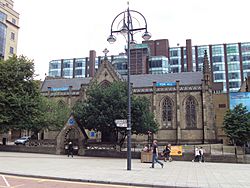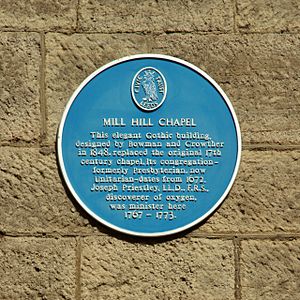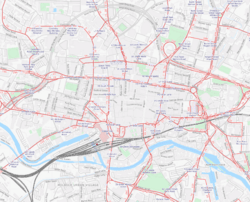Mill Hill Chapel facts for kids
Quick facts for kids Mill Hill Chapel |
|
|---|---|
| Mill Hill Unitarian Chapel | |
 |
|
| 53°47′48.15″N 1°32′47.93″W / 53.7967083°N 1.5466472°W | |
| OS grid reference | SE 29960 33473 |
| Location | Leeds City Square, West Yorkshire |
| Country | England |
| Denomination | Unitarianism |
| Previous denomination | Presbyterianism |
| Membership | 27 (2017) |
| Architecture | |
| Functional status | Active |
| Heritage designation | II* |
| Designated | 26 September 1963 |
| Architect(s) | Henry Bowman and J. S. Crowther |
| Architectural type | Church (building) |
| Style | Dissenting Gothic |
| Specifications | |
| Capacity | 120 |
| Administration | |
| District | The Yorkshire Union Of Unitarian And Free Christian Churches |
Mill Hill Chapel is a special church located in Leeds, West Yorkshire, England. It's a Unitarian church, which means it's part of a Christian group called the General Assembly of Unitarian and Free Christian Churches. This church building is very old and important. It stands right in the middle of Leeds City Square. In 1963, it was given a special Grade II* listed status. This means it's a protected building because of its history and architecture.
Contents
History of Mill Hill Chapel
Mill Hill Chapel has a long and interesting history. It was built a very long time ago.
Early Beginnings
The chapel was first built in 1674. This was only a few years after a big event called the Great Ejection. During this time, many religious people in England, known as Dissenters, wanted to worship in their own way. They built this chapel in the main town square of Leeds. One of the people who helped start it was the father of a famous historian named Ralph Thoresby. He helped guide the chapel towards the Dissenter movement. Over time, this movement at Mill Hill Chapel became known as Unitarianism.
The 18th Century Chapel
In the late 1700s, Mill Hill Chapel had a close connection with another church in Leeds called Call Lane Chapel. Many important families in Leeds were involved with both churches. These families included the Oates family from Potternewton and the Dixon family from Gledhow Hall. Some wealthy local people even had their own private Unitarian chaplains or "Preaching Rooms" on their estates.
From the late 18th century, Mill Hill Chapel became very popular with important people in the county. Many politicians, factory owners, and merchants supported it. The Lupton family, who also supported Call Lane Chapel, were some of its biggest helpers.
The 19th and Early 20th Centuries
The Kitson family was also very involved with the chapel. A famous artist named William Morris designed a beautiful window for Ann Kitson, who passed away in 1865. Her son, James Kitson, 1st Baron Airedale, paid for the chapel's vestry to be made bigger in 1897. After James passed away, another artist, Archibald Keightley Nicholson, created a window in his honor. This window showed how Christianity continued through time.
Many supporters of the Leeds Philosophical and Literary Society came from the chapel. This group was interested in science and learning. Mill Hill Chapel became known as "the mayors' nest" because so many mayors and later lord mayors of Leeds belonged to it. You can find memorials inside the chapel for people like Francis Garbutt (from 1847) and John Darnton Luccock (from 1864).
The church guidebook says that in the early 1900s, the chapel had a small but very active and important group of people. They were led by Revd Charles Hargrove and Sir James Kitson. Before World War I, a notable member was Jogendra Nath Sen. He came to study Electrical Engineering at the University of Leeds. He bravely volunteered to fight in September 1914 and joined a group of soldiers called the Leeds Pals.
The Chapel Today
A special sign outside the church tells us something important. It says that Mill Hill Chapel was the first place of worship in Leeds city center to hold a same-sex wedding. This shows how the chapel continues to be a welcoming and modern place.
Architecture of the Chapel
Mill Hill Chapel is located on the east side of Leeds City Square. Leeds was a very busy and rich city when the chapel was built. The architects, Henry Bowman and J. S. Crowther, designed the chapel in 1848. They used a style called Dissenting Gothic. Inside, the main part of the church, called the nave, still has its original Victorian pews. These are the long wooden benches where people sit. A sculptor named Robert Mawer created the beautiful stone carvings.
Leeds Civic Trust recognized how important this building is to the city. They placed a Blue Plaque on it.

Important Ministers of the Chapel
Many interesting people have served as ministers at Mill Hill Chapel over the years.
Early Ministers
Richard Stretton MA (oxon) became the minister at Mill Hill in 1672. In 1694, Timothy Manlove, who was also a doctor, was asked to be the minister.
The chapel was part of the English Dissent tradition. The people in the church kept their connections with English Presbyterianism until the early 1700s. But then, things changed a lot when Thomas Walker (who passed away in 1763) became minister in 1748. He was the uncle and guardian of George Walker, a mathematician and activist. George Walker was so important that he was included in the Dictionary of National Biography. Another famous person, Joseph Priestley, thought Thomas Walker's ideas were different from the usual. Many of Walker's sermons were written down by Joseph Ryder (1695–1768). Ryder kept detailed diaries of 5,000 sermons across Yorkshire. His relative, Olive Lupton, later inherited these diaries.
Joseph Priestley and William Wood
Joseph Priestley was the minister from 1767 to 1773. He helped guide the chapel towards Unitarianism. Priestley suggested that William Wood should be his successor. William Wood worked to help Nonconformists, who were people who didn't follow the official Church of England, get equal rights in politics and education. He also became a very skilled botanist, studying plants, during his time at the chapel until he passed away in 1808. His son, George William Wood, was born there.
Charles Wicksteed and Thomas Hincks
Rev Charles Wicksteed was the minister for a long time, from 1835 to 1854. After he retired, he wrote a book about the chapel's history. While he was in Leeds, he was the president of the Leeds Philosophical and Literary Society, a group interested in learning. He also helped start the Leeds Education Society, which was an early version of the National Education League. Charles Wicksteed was important across the country too. He helped edit a magazine called the Prospective Review for ten years. This magazine was important for the "new school" of English Unitarianism. He also helped shape the design of new chapels, encouraging the use of the Dissenting Gothic style.
From 1855, the minister was Thomas Hincks. He was a naturalist known for his studies of small sea creatures called zoophytes and bryozoa. He had to leave his job in 1869 because he lost his voice. He spent his retirement continuing his scientific work. In 1872, he was chosen to be a Fellow of the Royal Society, which is a great honor for scientists.
See also
- Grade II* listed buildings in Leeds
- Listed buildings in Leeds (City and Hunslet Ward - northern area)



